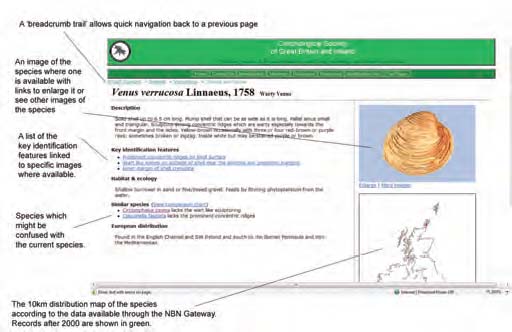Issue
17
Page
24
 Over 700 images and 250 species accounts are now available through an emerging “Encyclopedia of British Molluscs” which will form an important aspect of the Society’s website. This article gives an overview of the rationale behind the project, how far it has got, what is next and finally how you could get more involved.
Over 700 images and 250 species accounts are now available through an emerging “Encyclopedia of British Molluscs” which will form an important aspect of the Society’s website. This article gives an overview of the rationale behind the project, how far it has got, what is next and finally how you could get more involved.Background
It is hard to believe that it is about fifteen years since the first website and there are now over 8 billion pages available across the globe. It obviously provides a very cost effective means of publishing material and particularly images which are intrinsically relatively expensive to print. It also provides a route to new audiences that may not have access to printed publications and particularly the younger audience.
The Society has already embraced the Web and maintained an active website over the last five years. Indeed a revised version of the Society’s website has just been released. Sometime ago the Council recognised the benefit of having standard species pages available within the Society’s site that other sections of the site could reference to bring the subject more alive. For example, rather than simply presenting a list of scientific names that would mean nothing to a naive reader, each name could be linked to a page with more information including an image.
Current progress
Work began on the project two years ago and is progressing steadily. With over 600 marine species that would merit inclusion and about 200 non-marine the project will take quite a while to complete but there is already a substantial volume of content available principally around the Patellacea (Limpets), Mytilacea (Mussels), Pectinacea (Scallops), Mactracea (Trough shells), Tellinacea (Tellins), Solenacea (Razors) and Veneracea (Carpet shells).
To access the site simply go to http://www.conchsoc.org/encyclopedia. Note that it is draft and has not been linked up to the Society’s main site so none of the menu items in the top of the pages work. In addition, the actual look and feel will be integrated into the revised version of the Society’s website.
What is next?
In addition to providing a lookup for each of the British species the pages can obviously be linked from all sort of other places. Some examples which we have in mind include:
- On-line identification guides – providing introductory identification guides which are navigated through photographs is a good way to get beginners and new enthusiasts more interested. The identification guide itself could then link on to a full account of the species.
- Species lists in advance of a field trip – it is only a matter of time before the Society starts listing the species which have already been recorded from a site as preparation for a field trip. However, rather than just producing a list of species, which would potentially be meaningless for a new recorder, each species listed could link to its account allowing a new user to brush up before the actual meeting.
- Quizzes – as the whole system is databased it would be very easy to set up a system that randomly selects an image of a species and asks the user what it is. This sort of thing could be used to brush up your own identification skills and also potentially assess the level of competence of a recorder.
- Enhancing recording and field guides – another section of the Society’s site provides advice on where to look in particular habitats for molluscs and what you might expect to find. Again, at the moment, this is a list of scientific names – linking each name to an account helps bring it more alive for a novice.
How could you help?
There are all sorts of ways that could help to get this resource up and running:
- Providing general ideas on how the pages or navigation could be improved – the layout, content and navigation of the pages are intended as draft. Any comments or ideas on how they could be improved would be very welcome.
- Reviewing or editing sections that have been drafted – many of the accounts have been written by myself and I would not by any means consider myself expert. If you are prepared to look over species or groups that you are particularly familiar with that would really help to improve the quality of the information. I can provide the accounts for species or superfamily as a Word document that can be printed to make reviewing sections easier.
- Drafting accounts for species or groups you are particularly interested in – there are obviously many more accounts to be drafted and the non-marine species have not even been started yet. If you have a favoured species or group – why not draft an account and get it onto the Web.
- Providing specimens to be photographed – I, deliberately, do not have an extensive shell collection and so many accounts do not yet have images to accompany them. If you are prepared to lend specimens or bring them along to one of the Society’s meetings that would really help to fill in some of the gaps. • Providing photographs – alternatively, if you already have images of species that you would be prepared to publish through the Society’s website
If you would be prepared to help in anyway to get the site up and running then please do get in touch. My email address is SteveBWilkinson@btinternet.com. In the meantime, why not go and have a look at what is already available.
